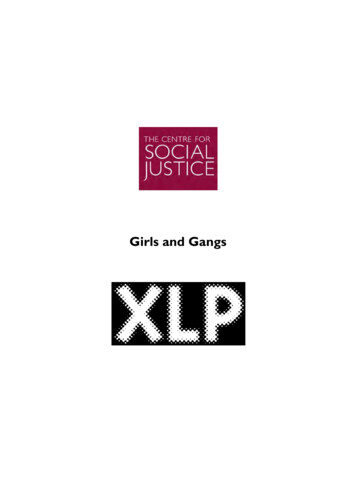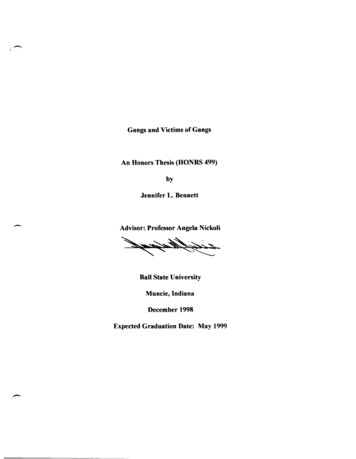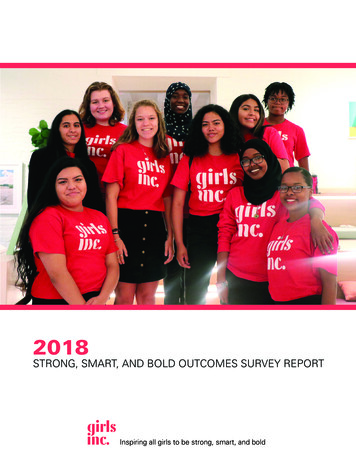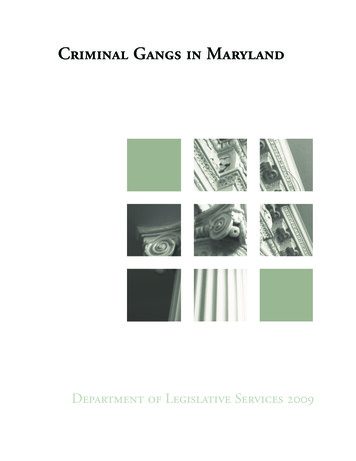
Transcription
Girls and Gangs
About the Centre for Social JusticeThe Centre for Social Justice (CSJ) is an independent think-tank, established to put social justice atthe heart of British politics.Moved by shocking levels of disadvantage across the nation, it studies the root causes of Britain’sacute social problems in partnership with its Alliance of over 350 grassroots charities and peopleaffected by poverty. This enables the CSJ to find and promote evidence-based, experience-ledsolutions to change lives and transform communities.The CSJ believes that the surest way to reverse social breakdown – and the poverty it creates – isto build resilience within individuals, families and the innovative organisations able to help them.The Centre for Social Justice’s Criminal JusticeProgrammeSocial justice and criminal justice go hand in hand. Not only does crime disproportionately affectpoorer communities, but those who have committed crime are also far more likely to suffer fromthe causes of social breakdown such as drug abuse, poor literacy rates and worklessness.Moreover, criminal sentences – whether prison or its alternatives – provide a unique opportunity tointervene in the often chaotic lives of those involved in criminal activity. By creating a just societywhere crime rates are low and the public feel confident about their safety, community cohesion andpride in local neighbourhoods can flourish.For these reasons, in early 2013 the CSJ launched a Criminal Justice Programme to find public policysolutions to entrenched criminal justice problems. The Programme will build on our previousreports on police, prison reform, and youth gangs, such as Locked-up Potential, A Force to be ReckonedWith, Rules of Engagement: Changing the heart of youth justice, Dying to Belong: An in-depth review ofstreet gangs in Britain, and Time to Wake Up: Tackling gangs one year after the riots.If you want to contribute to the Programme or have an interest in supporting our work we wouldbe delighted to hear from you. Please contact Edward Boyd, the Deputy Policy Director of the CSJat edward.boyd@centreforsocialjustice.org.uk.1
Introduction to XLPXLP is an urban youth charity working to create positive futures for young people living in innerLondon and make a serious and sustainable impact on poverty and educational failure. The overallaim of their work is to see young people living in inner-London making wise life choices andpositively contributing to their families, communities and society.XLP stands for "The eXceL Project" a charity at the cutting edge of urban youth work in London,started by Patrick Regan in Peckham, South London, in 1996 after a stabbing in a school playground.Today XLP serves young people in schools and communities across seven inner-London boroughs(Southwark, Lewisham, Greenwich, Newham, Tower Hamlets, Islington and Camden), working withover 1,800 young people each week on a one-to-one and small group basis, and engaging with over12,000 young people per year. They operate a range of prevention, diversion and interventionprogrammes such as schools work, after-school clubs, mentoring, arts and sports, and summercamps.2
AcknowledgementsThe CSJ and XLP would like to thank the many individuals and organisations that have generouslytaken time to contribute evidence to this report. Without them this report would not have beenpossible. We spoke to many girls and young women who are or have been gang-associated andmore than 30 organisations working to tackle gang problems. Whilst some voluntary organisationsgave their evidence anonymously, there are a number we would like to thank publically. They are:Abianda, BelEve UK, Catch 22, Centre for Mental Health, Changing Lives, Growing Against Gangs &Violence, Jags Foundation, Kids Company, Liminality Group, Manchester Active Voices, The NewRush Hall Group, Nia Ending Violence, Oasis Trust, Pecan, Redthread, Safe n' Sound, Safer LondonFoundation, St Giles Trust, Terriers, The MsUnderstood Partnership, and Vee's Place.We would also like to thank all those who took time to reply to our Freedom of Informationrequests, and the following individuals for their invaluable input: Polly Courtney, Selena Grey, KarlLokko, Helen Lyons, Natalie Ojevah, Professor Jenny Pearce, and Rachel Shand.Lastly, special thanks go to Aston Stockdale for his hard work to make this report a reality andHannah Bourazza, Simon Marchant, and Aiasha Khalid for their crucial work that laid the foundationfor this report.3
ContentsIntroduction . 5Chapter One: Gang life for girls . 71.1 Case studies of girls in gangs. 71.2 Common problems for girls in gangs . 11Chapter Two: Responding to girls in gangs . 192.1 Mapping the Problem . 192.2 Windows of Opportunity . 212.3 Effective Mentoring . 262.4 The police response . 302.5 Schools and gangs . 34Conclusion . 364
IntroductionGang violence continues to blight too many communities. As the CSJ has shown in two recentreports,1 gangs thrive when neighbourhoods are plagued by low employment, high family breakdown,addiction and poor educational achievement. The riots in August 2011 also highlighted the problem,with at least one in five of those arrested in London known to be part of a gang. 2 This wasrecognised by the Secretary of State for the Home Department, The Rt Hon Theresa May MP:‘One thing that the riots in August did do was to bring home to the entire country just how serious aproblem gang and youth violence has now become.’3The Government’s response to this, the Ending Gang and Youth Violence Programme, was heavilyinfluenced by the CSJ’s in-depth review of street gangs in the UK, Dying to Belong (2009). A year afterthe riots, however, we felt that the Government’s gang policy was drifting. Our report, Time toWake Up (2012), showed that a long-term vision or commitment to tackling this complex issue waslacking.This short paper again calls on the Government to present a coherent, far-sighted programme totackle the UK’s gang problem. In doing so it highlights the plight of girls and young women associatedwith gangs,4 who are often marginalised in discussion of these issues.What roles do girls play in gangs?The Children’s Commissioner identified a number of different roles girls take up within gangs: Gangster girls: young women who adopt male personas within gangs; Female family members of gang members; Wifeys/girlfriends: young women in a recognised relationship with gang-involved males; Baby-mothers: young women who have children with gang-involved males; Links: young women who are associated through ‘casual’ sex with one or more members ofthe gang.1Centre for Social Justice, Dying to Belong: An in-depth review of Street Gangs in Britain, London: Centre for SocialJustice, 2009 and Centre for Social Justice, Time to Wake Up: Tackling gangs one year after the riots, London:Centre for Social Justice, 20122Department for Communities and Local Government, Government Response to the Riots, Communities andVictims Panel’s final report, London: Department for Communities and Local Government, 2013, p123HM Government, Ending gang and youth violence: a cross-government report including further evidence and goodpractise case studies, London: HM Government, 2011, p34Whilst the primary focus of this paper is on girls (i.e. those under the age of 18) some of the stories and dataused in this paper were of young women over the age 185
The CSJ has heard how girls often get involved in gangs through relationships with male gangmembers. They have told us how attractive the ‘bad boy’ image can be, and how they are drawn inby the excitement, financial benefits and sense of belonging and protection gangs can provide. Wehave also heard that family breakdown, domestic violence in the home, a lack of positive role modelsand low self-esteem can push girls into the arms of gang members. However we still know too littleabout how many girls are involved in gangs, the extent of the problems they face, or how best wecan tackle this issue.The CSJ and the urban youth and community charity, XLP, have conducted this short research paperin order to shed further light on this important topic, and to help policy makers understand themyriad of problems that these girls face. In conducting this research we engaged with a wide range ofindividuals and organisations involved in gangs from across the UK, drawing on the expertise of theCSJ’s 350-strong Alliance of poverty-fighting charities. We spoke to many girls and young womenwho are or have been gang-associated and more than 30 organisations working to tackle gangproblems.The stories we have heard shocked us, and reveal a parallel world that too few policy makersunderstand. In listening to girls’ stories we have heard, amongst other things, about the toll gang lifeis taking on their education, and their families, friends and communities; the horror of sexualexploitation; and of an increase in criminal activity. Yet we also found several things that can be doneto help girls exit gang association, namely: mapping the problem; taking advantage of specific‘windows of opportunity’ to access girls; providing effective mentoring; ensuring an appropriatepolice response; and making sure gang-affected schools are open to support.This is far from an exhaustive list of issues – these are only the subjects that most often arose in theconversations we held with girls, charities and services. There is much more that can, and needs tobe said, on this topic that is outside the scope of this short paper. Yet we hope that this researchgives policy makers and community leaders an insight into a world that has been long-neglected, andempowers them to help support girls to exit gang association.6
Chapter One: Gang life for girlsTo truly understand the problems for girls in gangs it is best to start with their experiences. Thedata on girls and young women is unreliable and too little is known about the reality of gang life forthem. It has been estimated that ‘12,500 girls and young women are closely involved in gangs’5 yet thesefigures are crude at best. Despite recent good work exposing the level of sexual exploitation thatgirls in gangs face, 6 we still know too little about how gang life affects their education; families,friends and communities; or their propensity for criminality. It is only by listening to the girlsthemselves that we can start to understand the problems they have faced. This chapter sets out thestories of four girls: ‘Girl X’, Carly, Lauren and Danielle. The stories were accessed throughvoluntary organisations working with the girls, and have been written from the girl’s perspectives.1.1 Case studies of girls in gangsAll names have been changed to protect the girls’ identity.Case study one: Girl X’s storyAn outreach key worker describes her professional experience of previously working with a young girl. Theworker gives her anecdotal evidence to assist highlighting awareness and preventing this kind of abusehappening to other young people:The young girl grew up living with her father and three younger siblings on a housing estate in theUK. When the girl was 11 years-old she started dating a 14 year-old boy she met at school and whowas in a gang. He often tried to persuade this girl to have sexual intercourse with him, and by theage of 12 she agreed.Soon afterwards the girl found out that he had filmed them having sexual intercourse on his laptop.At this point the girl described to her worker that this boy's attitude towards her changeddramatically and he became aggressive and cold. The boy threatened to show her father the footageand post it on various social networking sites for all of their friends to see. The idea of thishappening terrified the young girl and she begged him not to do it. He agreed not to share thefootage, on one condition: that she must always be available to both him and any other gang memberfor sex. She was horrified, but was so scared about what her family and friends would think of her if5Pearce, J.J. and Pitts, J.M., Youth gangs, sexual violence and sexual exploitation: a scoping exercise The Office of theChildren’s Commissioner for England, Luton: University of Bedfordshire, 2011, p196For example see Beckett, H. et al, It’s wrong. but you get used to it: a qualitative study of gang-associated sexualviolence towards, and exploitation of, young people in England, Luton: University of Bedfordshire, 2013 and Pearce,J.J. and Pitts, J.M., Youth gangs, sexual violence and sexual exploitation: a scoping exercise The Office of the Children’sCommissioner for England, Luton: University of Bedfordshire, 20117
they saw the video so she agreed to his terms.From this moment on the 12 year-old girl's life descended into one of regular abuse and sexualexploitation. She was raped on a weekly basis, and many of these crimes were filmed and playedback to her by her rapists.On one occasion she was forced to give oral sex to around 20 gang members as they stood aroundher in a circle and beat her. She became so desperate; she would have done anything to make itstop.The gang then offered her a way out: if she found new girls for them, they would stop raping andabusing her. Again she agreed.The gang asked her to make friends with girls her age or younger. Once she had made friends withother girls, she would invite them round to her flat where roughly 20 gang members would bewaiting. Each time they would rape the new girl, and film the encounter to entrap the new girls.She was often physically forced to watch the other girls she had befriended being raped.Despite introducing the gang to new girls, she was still raped on occasion, though less frequently. Inorder to protect herself she stopped wearing make-up, cut her hair short and wore unflatteringbaggy clothes. This had its desired affect and increasingly the boys no longer saw her as desirable.When she was 14 years-old she was placed into care. Her social worker called in a voluntaryorganisation to support her. They helped move her out of the area and away from the gang.Case study two: Carly’s storyCarly told us her story in her own words:‘When I was about 15, I was beaten up by a younger girl and feared going back to school because ofbullying. Soon afterwards, I met a 20 year-old who was in a gang. He had money, a car and he said that hewas going to protect me, that no one was going to touch me and that if I needed anything he would give it tome. Instead of going to school I began to just sit at his house with his friends smoking weed, becomingexposed to gang violence and becoming sexually active.‘My body and mind was breaking down. From the innocence that I had, my life was self-destructing day byday. He became so controlling, he had control of where I went, who I spoke to. Whatever he said, I did. He8
started hitting me but when he did, he would say sorry and bought me things to make it up to me. Two yearslater, I was getting punched so hard that one time I was knocked out.‘At 17, I fell pregnant and at this point I realised that I was scared, that I didn’t want to be with him and Ididn’t want to raise a baby with him. I woke up to who was in my life. The midwife asked me who the fatherwas and when I told them they knew who he was because he was under the Mental Health Act with bipolar.The social services came in and that’s how I got out.‘ [A girl hoping to exit gang-association] will need a mentor because she needs to speak to somebody, tobuild up a relationship with someone she trusts. Young people are immature souls, if they have been brokenin any way then they have to be fixed back. Housing was crucial because if I never got out of that area, evenif I didn’t see him, I would have seen his friends and the friends think they’ve got control over you. It can be avery very dangerous situation when you’re trying to get that person out of your life but I got my escape.’Case study three: Danielle’s storyFrom a young age Danielle spent a lot of time with the boys on her estate, initially just hangingaround and playing football. But by the age of 11, what had started as loitering turned into anti-socialbehaviour and criminal damage, such as breaking windows. She also started to regularly get intofights at school.By the time she was 15 years-old, Danielle was part of a gang. She was not in a relationship with anyof them and they treated her in a similar manner to other male gang members. She craved theacceptance of others in the gang and took great pride in her involvement. Yet it came withobligations. Whenever anyone in her gang had issues with another girl, they would call on Danielleto fight them. Danielle developed a fierce reputation for fighting and often defeated girls severalyears older than her. On one occasion, when she was 17 years-old, she was called to help a friendwho was in an altercation with another girl. She agreed to help, borrowed a firearm from a fellowgang member and made her way down to the conflict. The situation was resolved without herdischarging the weapon.Around this time she also started selling cannabis and was entrusted by her gang to hold firearms.On one occasion a gun went missing in her household. Her fellow gang members held her and heryounger brother responsible. She bargained with the group and settled the matter by agreeing to selldrugs free of charge until she had paid off the cost of the gun.When Danielle reached the age of 19 she was introduced by her cousin to some of his friends. They9
were a positive influence on her life. She found them an inspiration and they influenced her to leavegang life behind. However this transformation was short lived and when a financial crisis hit she fellback into selling drugs with the gang to make money.She had another wake-up call a year later when she was called upon by the gang to make a drugtransaction. As she waited for the customer to arrive, two cars pulled up next to her and a group ofguys from a rival gang jumped out and threatened to take her life if she did not give them the drugs.She complied and they got back into the car and drove off. This made her feel extremely vulnerablefor the first time in many years and she resolved to never sell drugs again. She has now exited ganglife and has stopped selling drugs.Case study four: Lauren’s storyLauren and Craig first got together when she was 15 years-old. He was the most popular boy inschool and was part of a gang. Being Craig’s girlfriend meant people looked up to her, treated herwith respect and did not bully her.At least once a month Craig borrowed a car from an older boy in his gang and would meet Laurenat her school gates. Other pupils soon heard about who was picking her up in nice cars. Suddenly, allher peers were keen to win her favour. She liked the attention.On one occasion, when Lauren left class to go to the bathroom, some boys super-glued her pen toher book as a prank. On her return she sat down and tried to pick up the pen. As the book came upwith the pen, the whole class roared with laughter. She ran out, embarrassed. At the end of that daythe two boys who had pulled the prank came and frantically apologised to her and they gave hermoney to pay for another pen and exercise book. As they walked off she overheard them sayCraig’s nickname, and she became aware that they apologised because she was Craig’s girlfriend. Itmade her feel empowered and significant. She never had another prank pulled on her at school.When she turned 18 years-old, Craig asked Lauren if he could leave a shoebox in her room. Sheagreed and did not initially look in the box because she felt more comfortable not knowing what wasinside. Craig would regularly come and take things out of the box and put other things in. Onoccasion Lauren’s curiosity got the better of her and she looked inside to see drugs, money and – ontwo occasions – a gun. Yet she was never particularly afraid, and instead felt thrilled.As she grew older, Lauren spent more time in local bars and at raves where she regularly got intoconflicts. During one conflict a man threw his drink in her face. She immediately stormed out of the10
bar and called Craig. He came round with some members of his gang and stabbed the man and oneof his friends repeatedly. It was not a fatal stabbing but news quickly spread round about what hadhappened. She liked the attention it brought her. After this event friends asked her if she was afraidof Craig, but she was not. Instead, being with Craig made her feel safe and protected.Craig has since been arrested and imprisoned for three years after being caught committing aserious criminal offence. Whilst in prison he ordered a friend to access his ‘stash’ and release 5,000to give to her. Lauren is still in love with Craig and is looking forward to his release.1.2 Common problems for girls in gangsUnfortunately, these stories are far from unique. Instead they highlight problems that are commonto many girls and young women involved in gang life. When interviewing for this research brief weheard how being part of a gang is undermining girls’ educational attainment, impacting on theirfamilies, friends and communities, increasing the risk of sexual exploitation, and leading some girls toget involved in criminality. We explore how these themes are affecting lives below.Education and Schools‘We can’t compete with the attraction of fast cars, sex and drugs.’ Anonymousheadteacher in evidence to the CSJGaining a good education is one of the surest routes girls have out of the chaos of gang life, yet theirinvolvement is preventing them from achieving their academic potential and destroying their chancesfor a better life. The case studies above showed that girls’ education can be affected by theirinvolvement in gangs. Carly told us that ‘instead of going to school I began to just sit at his house with hisgang-associated friends smoking weed, becoming exposed to gang violence and becoming sexually active;’and Danielle’s fighting disrupted her studies.This pattern of gang involvement undermining educational attainment is reflected in national studies.One recently showed that ‘young women in gangs were over three times more likely to be underperforming at school than other women entering the YJS [Youth Justice System].’7Gang life is a distraction from education. One former gang-associated girl told the CSJ that ‘becauseof all the madness’ of gang involvement a girl is ‘going to lose her concentration.’ This view was reflectedby teachers. Dr D’Abbro, Head of the New Rush Hall School, told the CSJ:7Khan, L. et al., A need to belong: what leads girls to join gangs, London: Centre for Mental Health, 2013, p1411
‘I’m quite confident that many girl gang members wouldn’t see education as a life chance andtherefore their allegiance would be much more to gangs than it would be to coming to school.’He went on to explain the process of girls becoming associated with gangs:‘Over the space of a holiday or a couple of weeks, you can see somebody who suddenly dips down.they’re on to get five A*-Cs and then it just goes bang and when you look what happened it was justthat they got involved in gangs.’This process that John witnessed was also recognised by others. Another headteacher gave us thiscase study below.Watching a girl join a gang: a headteacher’s perspective‘Kate was a 16 year-old girl who was a motivated, high achieving student. She didn’t have a problem withattendance and achieved several A grades at GCSE. Then she became involved with a gang. We tried all wecould to keep her on board with education. For example, we gave her a business mentor who was a solicitoras the girl had held aspirations to become a lawyer, we took her on trips to university to give her a picture ofwhat life there could be like, we met with her mum (her father was not around), and made several socialcare referrals.‘None of this worked. We arranged for her to complete her application for 6th form but she never turnedup, and her attendance at school has plummeted. She is now coming into school later and later with thegang – often arriving at lunch time – sometimes clearly under the influence of legal highs or cannabis. Hermum initially encouraged her to do well at school, but resented any contact with other authorities. She nowappears to have given up completely trying to get her into school at all.‘All we have been able to do is send work home in the hope that she may complete some, but we don’t holdout much hope. She should be achieving top grades in 6th form and going onto university – she has thepotential – but she is unlikely to achieve anything in her education this year or in the years to come.’Guns, drugs and other criminality‘If the gang trust her then, yes - the likelihood of her safe housing firearms is high.’ KarlLokko, former gang memberIn the case studies we heard how Lauren and Danielle both held guns and drugs for their gang.These experiences are not uncommon and many of those giving evidence to the CSJ confirmed that12
this is often part of gang life for girls. The reasons why girls and young women hold guns and drugsinclude ‘love’, threats, through force and general association. Camila Batmanghelidjh, CEO of KidsCompany, told the CSJ:‘We’ve got evidence where little girls are being dressed in school uniform and the drugs are stashed intheir vagina and they’re made to sit in the front of the car. And it looks like Daddy is taking hisdaughter to school but actually they are carrying drugs. Girls are being used from a very young age, asyoung as 8 or 9.’Selena Gray, a journalist who grew up in a gang affected hot-spot explained to the CSJ that ‘for a girlto be asked to hold/hide firearms or drugs for a gang member she likes or is dating is no big deal. It's kind ofa privilege to be asked, it shows you've got his trust. No one really talked about the horrible consequences.’The Ending Gang and Youth Violence Programme, which was set up in 2011, has identified 33 localareas, spread across eight police force areas, which need action to tackle gang problems.8 Two ofthese police forces – the Metropolitan Police and Merseyside Police – cover two-thirds of theseareas, with the overwhelming majority being in London.The two police forces’ gangs units – Matrix in Merseyside Police and Trident in Metropolitan Police –have charged 98 females with firearms offences alone between January 2008 and March 2013 (20 inMerseyside and 78 in London).9 On average, girls charged with firearms offences were aged 23 inLondon and 27 in Merseyside.10 Previous CSJ research found that gang members were typically agedbetween 12 and 25.11 That those girls charged with offences have higher than average ages, suggestsyounger female offenders are not getting picked up.In London 56 per cent of those charged of Trident Firearms Offences since 2004 have been forpossession of a firearm, and 45 per cent have been charged on just four boroughs,12 including 20 inLambeth alone. To date no charges have occurred on Kensington & Chelsea, Camden,Hammersmith & Fulham, Harrow, Bexley, Richmond and Sutton boroughs.There are signs of a spike in women charged with firearms offences in London last year. TheMetropolitan Police have only been able to provide us with data on the first 70 days of 2013, inwhich time seven girls had already been charged. If this trend continued, 36 women will have been8The eight police force areas are: Derbyshire, Greater Manchester, Merseyside, Metropolitan Police,Nottinghamshire, South Yorkshire, West Midlands, and West Yorkshire9This information was provided to the CSJ by Merseyside Police and the Metropolitan Police Force10Please note that the average age of the girls charged with firearms offences covers different time periods foreach police force. For the Metropolitan Police the age is an average of all charges from January 2004 to March2013; whereas for Merseyside Police it covers from December 2007 to December 201311Centre for Social Justice, Dying to belong, London: Centre for Social Justice, 200912These boroughs are Lambeth, Waltham Forest, Southwark, and Haringey13
charged in 2013, representing a 180 per cent increase in women who were charged of TridentFirearms Offences in 2012.Given the hidden nature of girls in gangs, the police do not know all of those involved in criminality.As a result wider female juvenile (under the age of 18) crime trends are worth considering.In line with wider patterns, there has been an overall decrease in the number of female juvenileswho are arrested, however this has masked concerning increases in some specific areas, mostnotably arrests for drug offences.13Between 2004/5 and 2011/12 there was a 32 per cent increase (from 53 to 70) in the number offemale juveniles ar
To truly understand the problems for girls in gangs it is best to start with their experiences. The data on girls and young women is unreliable and too little is known about the reality of gang life for them. It has been estimated that '12,500 girls and young women are closely involved in gangs'5 yet these figures are crude at best.










